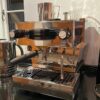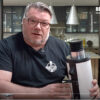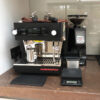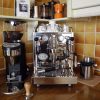HEAT EXCHANGER SYSTEM INSIDE AN ESPRESSO MACHINE
An espresso machine with heat exchanger system is a machine with two water circulation systems.
Since the boiler is not completely filled with water, steam may by drawn after the machine is fully heated. A heat exchanger is built into this boiler. When making coffee, fresh water from the tank is used which is pumped into the heat exchanger, heated there to the optimal brewing temperature and then directed to the brew group and portafilter. Thus, fresh water is always used to brew espresso.
Let’s clarify from our heat exchanger article with an explanation of the “Heat Exchanger (HX)”, a very fancy term for a copper tube that passes through hot water. In the picture below, we have built one, and as the cold water flows through the copper tube, immersed in a container of hot water, it gets heated up.
So the HX is really very simple and it is probably clear that the temperature of hot water exiting the heat exchanger depends on a number of things
- How hot the water in the container (boiler) is
- The surface area of the copper tube (or to put it simply, how long it is)
- The temperature of the water when it enters the copper tube
- How fast the water flows
The espresso machine designers will have to consider these factors in designing a machine that is able to produce enough hot water, without it being too hot and to minimise the requirements of a cooling flush. Now we have the “complexities of the very simple device that is the “Heat Exchanger” out of the way, lets move on to a simplified diagram of the insides of a real espresso machine
The diagram has been divided into 3 coloured sections for clarity.
Yellow Section
This section is what could be termed the cool side of the machine; it will contain the cold water tank (or possibly mains water inlet on a plumbed machine). Its task is to provide water at the correct pressure to the rest of the espresso machine. The pump can be either a Vibration pump, or in the case of a machine like my Izzo Alex, a rotary pump. Its sole purpose is to pump water at high pressure (9 or 10 bar).
Note: Vibration pumps are unregulated and deliver water at a pressure of 15 bar (much too high for espresso). Rotary pumps have their own internal pressure regulation and can be regulated to deliver water directly at 9 bar.
The water is drawn from the cold water tank, into the vibration pump, and through a device called an OPV (pressure release valve) which lowers it’s pressure. You will notice that this OPV has a tube leading back to the cold water tank, because to regulate water pressure down to 9 or 10 bar, it has to allow some of the water back to the tank rather than into the machine (see OPV article for more information on how the OPV works).
The water now passes from the OPV to the rest of the machine; this water can now only exert a maximum static pressure of 9 or 10 bar. It next comes to something called an “Autofill Solenoid”. The “Autofill Solenoid” has two positions:
- Water is directed to the E61 group (via the HX) for making coffee (normally in this position)
- Water is directed into the main boiler to refill e.g. after steaming, or using hot water.
The function of this solenoid, as you may have guessed, is simply to ensure the main boiler can fill when needed, without pushing water through the E61 group.
The water leaves the yellow section, able to exert a maximum static pressure of 9 or 10 bar, fine for making coffee and at a high enough pressure to fill our boiler (which is usually kept at around 1.3 bar).
Red Section
This can be termed the hot side of the machine, it’s where the water gets heated, steam is produced and everything is prepared for coffee making.
The main component of this section is the Boiler, as you can see it is full of hot water and steam. It can do this because the boiler is like a pressure cooker and inside it’s at a higher pressure than atmospheric. In fact the boiler is usually at around 1.2 bar. This means we have water at around 124C (yes hotter than boiling which is 100C) and an area of steam above the hot water. The boiler is maintained at this pressure by the little pressurestat which switches the heating element on/off as required to maintain 1.2 bar. These pressurestats are usually adjustable, via an adjuster on top (using a screwdriver.).
- When we open the steam tap, steam comes out and the pressure in the boiler drops, this causes the water to instantly boil, producing more steam…very simple
- When we open the hot water tap, steam pressure forces the water out
The autofill probe is just in the water, but when the water level drops as in steaming or drawing hot water, it senses this drop in level and tells the Control Board (brain). The brain then switches on the pump and sets the autofill solenoid to the fill the boiler position. Once the water level reaches the probe, the pump switches off and the autofill solenoid goes back to the making coffee position.
You can clearly see the HX tube within the boiler and this works no differently to the simple diagram given earlier.
Tan (or Coffee Coloured) Section
This is the business end of the machine, the part you normally see and interact with. All the previous wizardry was to deliver hot water at about 93-96C and 9 bar (140 psi) to this part of the machine for making coffee. Move lever up, pump starts, water passes through HX into group at 9 bar, into portafilter and through coffee….mmmm espresso!
The only slight complexity here is shown in the area marked by the green dashed line. The E61 thermosyphon (link). This is a simple passive circuit that allows convection currents to circulate through the E61 group to keep it hot (this increases temperature stability during the shot). You can read much more about it in the E61 thermosyphon article.
Lastly the poor old control board…well it’s box of electronics and controls the pump, water level, autofill solenoids and even has a protective circuit that prevents the heating element coming on if the boiler needs filling. It does a few other fancy functions at switch on, but it’s really a simple device. They are sometimes called level controllers and are usually made by Giemme or Gicar for prosumer machines. They are not meant to be user serviceable and if they go wrong are usually replaced. However often a fault is a simple transformer that runs one of the solenoids and these can sometimes be purchased cheaply for a few pounds and replaced using a soldering iron.









Recent Comments